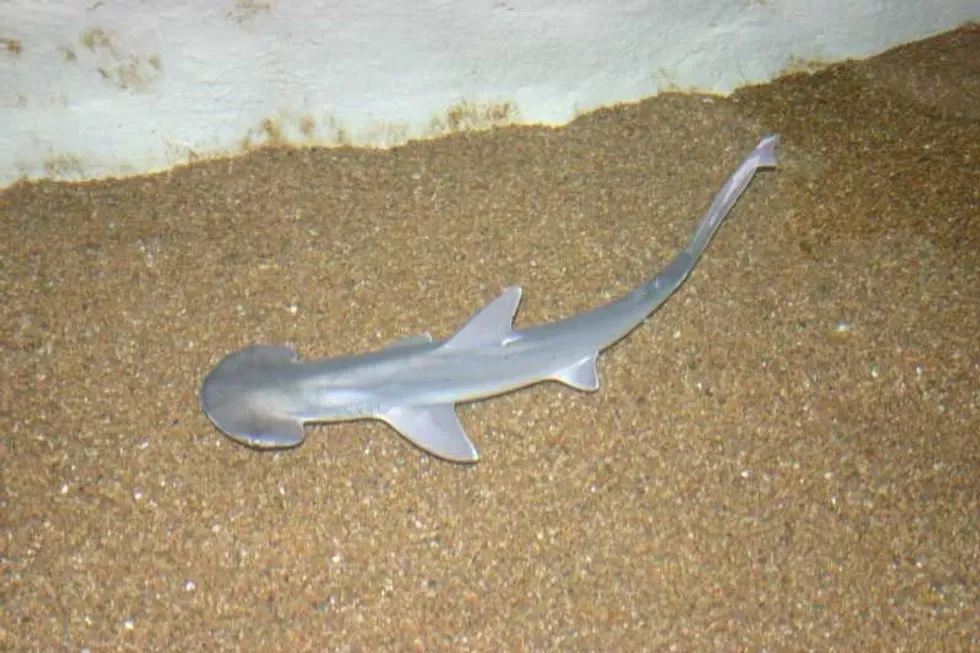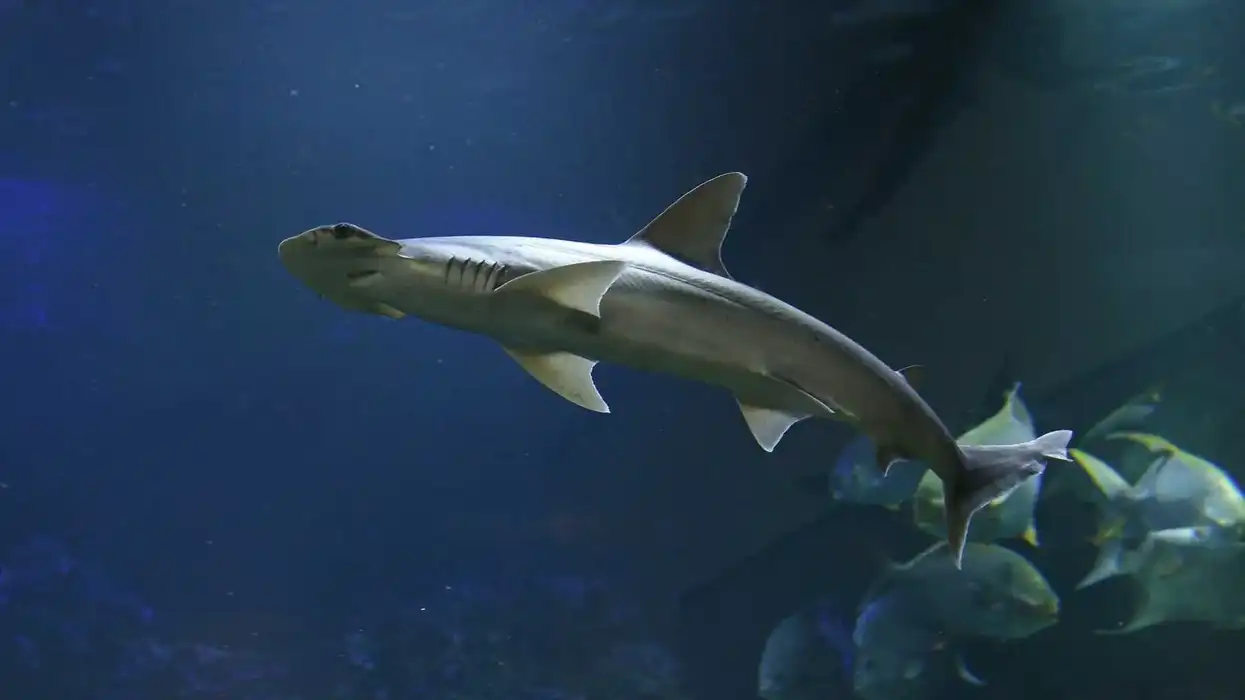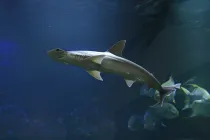Fun Bonnethead Shark Facts For Kids

Bonnethead sharks, also known as a shovelhead shark or a bonnet shark, are the smallest sharks in the family of Sphyrnidae. They are can be found from North Carolina to Brazil and southern California to Ecuador, including the north Atlantic, western Atlantic, eastern Pacific Ocean, the Gulf of Mexico, and Florida waters.
This marine animal prefers warmer water, and so they migrate to Florida where the water is generally warmer. They live in oceans, bays, insular shelves, estuaries, coastal areas, mud bottoms, and coral reefs.
The scalloped bonnethead shark is a species that is known for its shaped head which is smoothly rounded.
Bonnetheads have small hammers in comparison to hammerheads. Moreover, the pectoral fins in bonnetheads are also smaller than those of hammerheads.
The color of this shark varies from its head to base, with the upper and top portions being gray and the base being white. Their diet mainly comprises of crustaceans such as blue crabs, but they even feed on some small bony fish, mollusks, shrimps, snails, and bivalves.
Females capture more prey than males, and they have an excellent metabolism and storage. Hence, females are comparatively larger than males.
Bonnetheads are harmless to humans, and so they are suitable for keeping in captivity and are also found in aquarium displays. This shark species is edible and is suitable for human consumption and the best way to cook a bonnethead is by grilling them.
To know more about these fascinating animals, we have gathered a set of interesting facts about them for you to read. You can also find out about other sharks in our articles about nurse sharks and blacktip reef sharks.
Bonnethead Shark Interesting Facts
What type of animal is a bonnethead shark?
A bonnethead shark is a type of shark which is also known as a bonnet shark or a shovelhead shark. It belongs to the smallest group of sharks in the Sphyrnidae family.
What class of animal does a bonnethead shark belong to?
A bonnethead shark belongs to the class of Chondrichthyes.
How many bonnethead sharks are there in the world?
There is no authentic data on how many bonnethead sharks there are in the world at this moment. However, their population is on the decline as they are marked as Endangered.
Where does a bonnethead shark live?
They live in oceans, bays, insular shelves, estuaries, coastal areas, mud bottoms, and coral reefs. They prefer warmer waters on the littoral zones of the North American coasts of subtropical and tropical waters.
They range from North Carolina to Brazil and southern California to Ecuador, including the north Atlantic, Florida waters, western Atlantic, eastern Pacific Ocean, and the Gulf of Mexico.
What is a bonnethead shark's habitat?
A bonnethead shark's habitat mainly includes marine, coastal, and shallow bays. They are frequently seen on the coastline of deep Florida waters and on the subtropical coasts of the western Atlantic.
During the winter and colder months, they move to warmer areas and into deep seaside waters. The water temperature should be above 70 F (21 C) as they are prefer warmer waters.
These sharks generally migrate in large groups of sharks called a 'shiver' where a social order or hierarchy is constructed according to a shark's size and sex. Migration depends on the place, temperature of the water, and the season.
They reside on reefs, insular shelves, aloft estuaries, and in shallow bays. Bonnethead sharks often travel long distances in order to find a suitable water temperature.
Who do bonnethead sharks live with?
Bonnethead sharks live in large groups of sharks called 'shivers' or 'colonies, and these shivers are likely to have around four to 15 sharks.
How long does a bonnethead shark live?
This shark species has a life expectancy of around 12 years.
How do they reproduce?
Bonnethead sharks (Sphyrna tiburo) use sexual reproduction and they are viviparous which means females give birth to their young ones or pups. In or around the spawning season, these sharks are found together in mating groups.
Females give birth to their pups in shallow waters, and each litter consists of eight to 12 pups. Their gestation period is considered the shortest out of all shark species, and is four to five months long.
Embryonic development takes place and the yolk sac placenta nourishes the embryos. This means that the females' uterine walls are connected to the yolk sac.
Throughout the embryonic development stage, a female's uterus is divided into two sections where the yolk sac placenta and the embryo are placed into two distinct compartments. A newborn pup is about 12 in (30 cm) long and weighs 0.5 lb (226 g).
Males reach sexual maturity when they are around 24 in (61 cm) long, whereas females attain maturity when they are around 32 in (81 cm) long.
They are generally born during the late summer or early autumn, and at the time of birth, they weigh around 0.37 lb (168 g). Interestingly, bonnethead sharks are the only shark species that are known to exhibit sexual dimorphism.
Their population is dependant on some factors such as the availability of food, the rate of embryonic development, seasonal changes, the duration of the gestation period, the energetic investment in producing offspring, and age, size, and time of maturation.
What is their conservation status?
Bonnetheads were previously categorized as Least Concern by the IUCN, International Union for Conservation of Nature but due to a major decline in their population, they are now declared as Endangered.
Bonnethead Shark Fun Facts
What do bonnethead sharks look like?
Its broad, smooth spade-shaped head distinguishes a bonnethead shark from other species of sharks. They have the smallest hammerhead (cephalofoil) amongst the hammerheads and they are in the family of Sphyrnidae.
Their eyes are located in between the anterior margin of their flattened head, and their lobes are smoothly rounded which increases the field of vision.
They have an arched mouth with enlarged dentition, with the edges of the mouth inhibiting posterior to oculofacial expansion which is the lateral expansion of their head. Their frontal dentition is even-edged and upright, whereas their other teeth are bent with oblique cusps.
This species has flat crushers that are modified from the outermost tooth located in the lower jaw. Also, they have a high dorsal fin situated on the rear side of the base of their pectoral fins.
They actively use these pectoral fins while swimming. Their skin is made of placoid scales, known as dermal denticles, a tough matrix with a tooth-like structure, and the texture is rough as that of sandpaper.
The color of their body ranges from gray-brown to gray-white, and at times there are tints of green.
On the sides of their body, these sharks have dark speckles. The color of bonnetheads varies from head to base, with the upper and top portions being gray and the base being white.

How cute are they?
Bonnetheads are considered to be scary as they are a member of the shark family, but at times some baby bonnethead sharks can be cute.
How do they communicate?
Bonnethead sharks, Sphyrna tiburo, are very social creatures, and they mostly live in groups. They are known to communicate and interact with each other via chemical channels. Apart from that, they often use tactile and physical channels to communicate.
How big is a bonnethead shark?
A bonnethead shark, Sphyrna tiburo, has the smallest hammerhead (cephalofoil) amongst the hammerheads and the family of Sphyrnidae. An average bonnethead shark size is 30-48 in (76.2-121.9 cm) long.
The largest bonnethead shark discovered was 59 in (150cm) long. Females are generally bigger than males. Bonnetheads are almost three times smaller than nurse sharks which have a length of 120 in (305 cm).
How fast can a bonnethead shark swim?
Although bonnethead sharks are active and migratory species, their efficiency and rate of speed are slow. Its locomotory rate and metabolism are almost equal to that of a typical bony fish.
For instance, a 17.6 lb (8 kg) bonnethead shark can travel 516 mi (830 km) in 23 days which is almost similar to the locomotory system of a bony fish.
How much does a bonnethead shark weigh?
Bonnethead sharks weigh 13-28 lb (5.8-12.7 kg) approximately.
What are their male and female names of the species?
There are no individual names given to them in terms of gender. Both males and females are called bonnethead sharks. The scientific name of a bonnethead shark is Sphyrna tiburo.
What would you call a baby bonnethead shark?
A bonnethead shark baby or babies is referred to as a 'pup' or 'pups'.
What do they eat?
Bonnetheads are diurnal, which means they generally forage during the day and are most active during the late afternoon. Their diet mainly comprises of crustaceans such as blue crabs, but at times they even feed on small bony fishes, mollusks, shrimps, snails, and bivalves.
Their diet also includes seagrasses. Unlike other hammerhead sharks who do not prey on invertebrates, bonnethead sharks have a powerful enlarged dentition which enables them to feed on both hard shell creatures as well as on soft-bodied ones.
The bonnethead shark kingdom is omnivorous and they are likely to prey on both marine creatures as well as seagrasses.
Females are likely to prey and consume more often than males as they need a higher metabolism and energy rate in order to reproduce and give birth to young ones. They also store a large amount of food and nutrients for the healthy embryonic development of their young ones while they reproduce.
Bonnethead sharks' jaws have a unique two-phase jaw-closing technique that helps them to bite and crush even hard shells such as snails and crabs.
This specialization increases their ability to catch and crush all sorts of prey, and this makes it easier for their food to be processed by their esophagus. Like most hammerhead sharks, they also have the ability to replace any broken or lost tooth.
Pups usually feed on small crabs and shrimps while swimming around.
Are they aggressive?
No, they are peaceful creatures and are harmless to humans. However, as they belong to the family of sharks, they can pose harm when startled or provoked.
They are amazing predators and are not territorial. Moreover, it is observed that eating bonnethead shark is good for your health, and their grills are perfect for human consumption. There is no information on bonnethead shark attacks currently.
Would they make a good pet?
A bonnethead shark pet is usually kept in captivity and is displayed in an aquarium. These are excellent creatures and are harmless to humans as they do not bite. It is important that they are kept in a proper bonnethead shark tank and the right habitat, however ultimately they are a wild animal.
Did you know...
Bonnetheads are considered to have a vision of 360 degrees and an outstanding depth perception which helps them to catch prey and be aware of any threats.
What is special about a bonnethead shark?
Interestingly, they have the ability to secrete cerebrospinal fluid which is how they communicate with one another.
What is another name for a bonnethead shark?
A bonnethead hammerhead shark is also known as a shovelhead shark or a bonnet shark.
Here at Kidadl, we have carefully created lots of interesting family-friendly animal facts for everyone to discover! Learn more about some other fish, including great white shark or thresher shark.
You can even occupy yourself at home by drawing one on our shark coloring pages.
We Want Your Photos!
More for You
See All
Bachelor of Arts specializing in Journalism and Mass Communication, Postgraduate Diploma in Sports Management

Moumita DuttaBachelor of Arts specializing in Journalism and Mass Communication, Postgraduate Diploma in Sports Management
A content writer and editor with a passion for sports, Moumita has honed her skills in producing compelling match reports and stories about sporting heroes. She holds a degree in Journalism and Mass Communication from the Indian Institute of Social Welfare and Business Management, Calcutta University, alongside a postgraduate diploma in Sports Management.
Bachelor of Journalism and Mass Communication

Ambuj TripathiBachelor of Journalism and Mass Communication
Ambuj is a skilled fact checker with a Bachelor's degree in Journalism and Mass Communication from Amity University. He has been recognized for his exceptional content writing skills, having won a CineMedia competition. In addition to his writing abilities, he also has a flair for design.
Disclaimer
1) Kidadl is independent and to make our service free to you the reader we are supported by advertising. We hope you love our recommendations for products and services! What we suggest is selected independently by the Kidadl team. If you purchase using the Buy Now button we may earn a small commission. This does not influence our choices. Prices are correct and items are available at the time the article was published but we cannot guarantee that on the time of reading. Please note that Kidadl is a participant in the Amazon Services LLC Associates Program, an affiliate advertising program designed to provide a means for sites to earn advertising fees by advertising and linking to Amazon. We also link to other websites, but are not responsible for their content.
2) At Kidadl, we strive to recommend the very best activities and events. We will always aim to give you accurate information at the date of publication - however, information does change, so it’s important you do your own research, double-check and make the decision that is right for your family. We recognise that not all activities and ideas are appropriate for all children and families or in all circumstances. Our recommended activities are based on age but these are a guide. We recommend that these ideas are used as inspiration, that ideas are undertaken with appropriate adult supervision, and that each adult uses their own discretion and knowledge of their children to consider the safety and suitability. Kidadl cannot accept liability for the execution of these ideas, and parental supervision is advised at all times, as safety is paramount. Anyone using the information provided by Kidadl does so at their own risk and we can not accept liability if things go wrong.
3) Because we are an educational resource, we have quotes and facts about a range of historical and modern figures. We do not endorse the actions of or rhetoric of all the people included in these collections, but we think they are important for growing minds to learn about under the guidance of parents or guardians.







